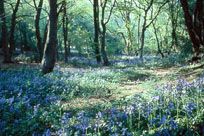
Deciduous woodland is the natural, original vegetation of most of the country. Most of our native terrestrial mollusc species can be found in such woods. In old, calcareous woods, totals of 30 or more species are not uncommon for a few hectares; where there are wet patches, and long-term traditional management, the total can reach 50-60. Woods on chalk or limestone tend to be richer than those with more acid (oligotrophic) soils. Steep slopes and rocky outcrops are also beneficial, as is lots of fallen timber. Wet patches (mini-fens, springs, small streams) boost the total even more.
Most of the species found in woods can tolerate quite a bit of disturbance, and they can be found in hedges, waste ground, gardens and parks. These species can usually colonise newly planted woods easily. The species listed below seem to be rather more demanding. If several of them are found in a wood, it is likely to be old, and of some conservation significance. Some are geographically restricted; in general faunas in the south are richer than those further north.
Associated species
- Abida secale secale - Rare; mainly on rocks or in open woodland. Occurs on rocky limestone grassland too.
- Acicula fusca - Frequent in eutrophic woodlands.
- Aegopinella pura - Common.
- Azeca goodalli - Occasional; generally in wet, mossy places in woods. Also in ancient hedges and in the open in very wet regions in the north.
- Cochlodina laminata - Frequent, but common in eutrophic woodlands.
- Columella aspera - Occasional, but frequent in oligotrophic woods; rare to very rare in eutrophic ones. Not confined to woods.
- Ena montana - Rare; geographically restricted; can be locally abundant, especially in Cotswolds.
- Helicigona lapicida lapicida - Scarce; Widespread, but hard to find in dry weather; probably frequent in high quality woods. Rare to extinct in the east. Often found in open habitats in the north where there is exposure of limestone.
- Helicodonta obvoluta obvoluta - Rare; geographically restricted to western South Downs and Hampshire Downs: can be frequent within its range.
- Leiostyla anglica - Rare, but perhaps frequent in wet patches within woods especially in the west. Not in dry eastern / central woods.
- Malacolimax tenellus - Scarce; widespread, but known from rather few localities. Possibly favoured in oligotrophic, even coniferous, woodland. A good indicator of ancient woodland where it occurs.
- Limax cinereoniger - Scarce. Probably the most reliable indicator of ancient, semi-natural woodland.
- Macrogastra rolphii - Scarce. South only; can be very abundant in some districts (eg South Downs).
- Phenacolimax major - Scarce. South only, and bias towards west.
- Spermodea lamellata - Rare; mainly northern, and perhaps more in oligotrophic woods.
- Tandonia rustica - Very rare.
- Vertigo substriata - Scarce; mostly northern, and especially in wet woods or wet patches within woods. Also found in open wetlands: fens.
- Zenobiella subrufescens - Scarce; very rare or absent in the east; in many woods in the west, but never found in large numbers.
